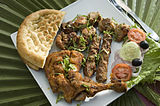Sarson ka saag
 Makki ki roti with sarson ka saag | |
| Alternative names | Sarsan da saag/Sareyan da saag (Punjabi) |
|---|---|
| Course | Main course |
| Place of origin | Northern Indian subcontinent |
| Associated cuisine | Pakistan, India, Punjabi[1] |
| Main ingredients | Mustard leaves |
Sarson ka saag, also known as sarsa ka saag, is a dish of mustard greens cooked with spices. It originated in the north of the Indian subcontinent and is popular throughout the region.[2][3][4][5][6]
Name
[edit]The dish is known as sarson ka saag in Hindi, sarson da saag (or sareyan da saag in Punjabi,[7][4][8] sarsav nu shaak in Gujarati,[9] and sariso saag in Maithili.[10]
Sarson, sarhon, sareyan, etc. derive from the Sanskrit word sarṣapa "mustard.[11] Saag/shaak derives from the Sanskrit word śāka "greens; vegetable leaves".[12]
Ingredients and preparation
[edit]Mustard is widely grown in the region for the plant's leaves, seeds and seed oil. It is harvested in winter and spring, making sarson ka saag a popular warming dish in the cooler months.[13][14][15]
There are many recipes for the dish, usually cooking the leaves in oil or clarified butter (ghee)[16] with spices such as garlic, ginger and chilli. Other spices used vary according to region and taste.
Accompaniments
[edit]The dish is often served with bread such as makki ki roti or bajra ki roti.[17]
See also
[edit]References
[edit]- ^ Rai Gupta, Kulwant (2006). Studies in World Affairs. Vol. 2. Atlantic Publishers & Distributors. p. 289. ISBN 9788126904969.
- ^ Dọgarī loka-gīta (in Hindi). Kalacarala Akādamī. 1964.
- ^ Excelsior, Daily (29 September 2018). "Promotion of Dogra culture". Jammu Kashmir Latest News | Tourism | Breaking News J&K. Retrieved 16 June 2022.
..Dogra cuisine such as Pathores, Makki ki Roti and Sarson ka Saag, Keurs...
- ^ a b Hamārā sāhitya (in Hindi). Lalitakalā, Saṃskṛti, va Sāhitya Akādamī, Jammū-Kaśmīra. 1995.
- ^ Agrawal, Chandresh; books, nandini (1 June 2022). HPPSC-Himachal Pradesh Drug Inspector Exam Ebook-PDF: All Sections Covered. Chandresh Agrawal.
Himachali specialities include Siddu....Makki ki Roti & Sarson Ka Saag
- ^ "History - Government of Himachal Pradesh, India". himachal.nic.in. Retrieved 19 June 2022.
- ^ Misra, Anoop (2012). Dietary Considerations in Diabetes - ECAB. Elsevier Health Sciences. p. 79. ISBN 9788131232095.
- ^ Bhandari, Laveesh (2009). Indian States At A Glance 2008-09: Performance, Facts And Figures - Punjab. New York: Pearson Education. p. 29. ISBN 9788131723456.
- ^ Gujarati, Team Recipe in (21 December 2022). "ઢાબા જેવુજ ટેસ્ટી સરસવ નું શાક - સરસો દા સાગ બનાવવાની રીત". Recipe in Gujarati. Retrieved 4 April 2023.
- ^ "Biriya Curry: A Maithil Delicacy Made with Chickpea Greens". GOYA. 19 August 2021. Retrieved 11 April 2023.
No meal within the Maithil community is considered complete without the inclusion of leafy dishes known as saag. Our cuisine is an ode to saag: bathua, laal saag, patua saag, genhari, karmi, sariso saag.
- ^ McGregor, R. S. (Ronald Stuart) (1993). "The Oxford Hindi-English dictionary". dsal.uchicago.edu. Retrieved 16 June 2022.
- ^ Platts, John T. (John Thompson) (1884). "A Dictionary of Urdu, Classical Hindi, and English". dsal.uchicago.edu. Retrieved 16 June 2022.
- ^ "Sarson ka saag / Makki ki roti". dawn.com. 19 February 2014. Retrieved 27 February 2017.
- ^ "Growing more mustard can make India self sufficient in edible oils". Gaonconnection | Your Connection with Rural India. 22 December 2021. Retrieved 16 June 2022.
Mustard is cultivated extensively in north India.
- ^ O'Brien, Charmaine (2013). The Penguin Food Guide to India. Penguin Books Limited. p. 38. ISBN 9789351185758.
In the winter months in Punjab, a richly spiced puree of mustard greens is eaten, accompanied with roti made of ground maize and a knob of fresh, soft, crumbly gur. The classic combination is called sarson ka saag and makki ki roti. Mustard has been grown in Punjab for millennia and its oil-rich seed is an important commercial crop.
- ^ Jiggs Kalra, Pushpesh Pant, "Classic Cooking Of Punjab", tumhari aisi kitasi Allied Publishers, 2004, ISBN 81-7764-566-8, page 42.
- ^ Laveesh Bhandari, Sumita Kale, "Indian states at a glance, 2008-09: Punjab : performance, facts and figures", Pearson Education India, 2009, ISBN 81-317-2345-3, section 4.7.2




